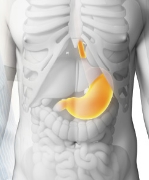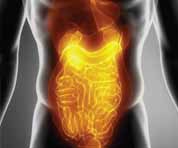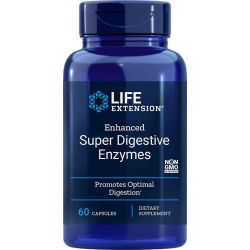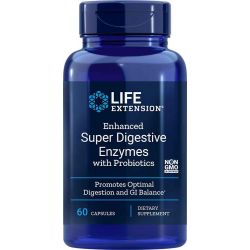Digestive Enzymes. Are You Obtaining the Proper Enzymes?
 Even if you eat a healthy diet, you may not be absorbing vital fat-soluble nutrients and amino acids needed for optimal health. That's because with age, we experience a decline in the enzymes our bodies produce to break down foods into absorbable nutrients.1-3
Even if you eat a healthy diet, you may not be absorbing vital fat-soluble nutrients and amino acids needed for optimal health. That's because with age, we experience a decline in the enzymes our bodies produce to break down foods into absorbable nutrients.1-3
Fortunately, studies show that by supplementing with the right mixture of digestive enzymes, older adults can take meaningful steps to maintain their digestive health.4,5 The result can be better digestion, less abdominal distress, and greater assimilation of vital nutrients like vitamins K, D, and omega-3s.6-8
The downside to many digestive enzyme supplements is that they contain specific amylases that facilitate that breakdown of dietary starches into rapidly-absorbed glucose.9
The concern is that most aging people already have higher than desirable fasting and after-meal blood glucose levels. A large body of published research documents increased risk of vascular disease, cancer, kidney failure, and diabetic eye problems in response to elevated glucose.10-18
Those with specific medical conditions (like pancreatitis) benefit from digestive enzyme formulas that contain amylases.19 The typical aging person, however, is better off taking a digestive enzyme formula that facilitates digestion of protein, fibers, and beneficial fats, but does not promote breakdown of starches that are rapidly absorbed as glucose.20
This article describes some prevalent digestive problems, including esophageal reflux, and a simple solution that does not promote excess absorption of glucose.
Problems with the Modern Diet
 Almost none of the foods we eat could be absorbed into our bloodstreams without the action of powerful enzymes that breakdown food in order to extract vital nutrients. Without this break down of the food matrix, undigested food passes into the colon, where it can lead to bloating, gas, diarrhea, and cramping. But even worse than these uncomfortable symptoms, poorly digested food contributes to the malnutrition that threatens older people who are already facing reduced appetite and changes in muscle and fat stores.21,22
Almost none of the foods we eat could be absorbed into our bloodstreams without the action of powerful enzymes that breakdown food in order to extract vital nutrients. Without this break down of the food matrix, undigested food passes into the colon, where it can lead to bloating, gas, diarrhea, and cramping. But even worse than these uncomfortable symptoms, poorly digested food contributes to the malnutrition that threatens older people who are already facing reduced appetite and changes in muscle and fat stores.21,22
Not surprisingly, poor oral health—even just wearing dentures—can reduce the efficiency of chewing, putting an extra burden on already-taxed digestive enzymes.23 That's why supplementing with enzymes is important not just for healthy digestion—but for good health in general.
If we ate a purely raw food diet, we wouldn't need supplemental digestive enzymes. Raw food contains its own enzymes to help kick-start the digestive process.24
Because the modern diet consists primarily of cooked, processed foods, our bodies need to rely almost exclusively on our own natural digestive enzymes. The problem is that as we age, we produce fewer of the enzymes necessary for healthy digestion, which makes it difficult for our bodies to properly breakdown food.
Evidence for Supplementing With Digestive Enzymes
 Adding natural enzymes to the human diet is not a new idea. It's been 70 years since scientists first recognized the importance of enzymes in raw foods to boost human nutrition.24 Those early scientists noted that providing supplementary enzymes could restore the rapid digestion of foods in the stomach, mimicking the self-digestion that takes place when people consume raw foods.24
Adding natural enzymes to the human diet is not a new idea. It's been 70 years since scientists first recognized the importance of enzymes in raw foods to boost human nutrition.24 Those early scientists noted that providing supplementary enzymes could restore the rapid digestion of foods in the stomach, mimicking the self-digestion that takes place when people consume raw foods.24
There's also a long medical history of using supplementary digestive enzymes in caring for people with various chronic digestive diseases. People with cystic fibrosis take pancreatic enzyme formulas to help them breakdown proteins, fats, and other nutrients they could not digest well otherwise.25 Individuals with chronic pancreatitis may use lipases to help them breakdown fats.26
But there's growing evidence that suggests that even if you don't suffer from a specific enzyme deficiency, you may benefit from supplementing with helpful digestive enzymes.
Proteases
Protein-digesting enzymes called proteases are generated naturally from the pancreas, which channels them into the small intestine via a short duct. Using supplemental proteases eases the burden on the body of producing these complex enzymes entirely on its own.24 Studies have shown that animals supplemented with proteases experience enhanced digestion.27
One important reason to supplement with proteases is to reduce the risk of intolerance reactions to foods such as meat proteins, gluten (from wheat) and casein (from milk).28 The structures of these food molecules make them relatively resistant to the limited enzymatic activity in the aging digestive tract. When proteins arrive relatively undigested in the lower intestinal tract, they can trigger inflammation, excessive mucous production, cramping, and even bleeding. Millions of people suffer from gluten intolerance or milk protein intolerance.29,30 Fortunately, the use of supplemental proteases may help ease their discomfort.31
Aging individuals may receive the greatest potential benefits from supplementing with protease enzymes in order to speed protein digestion. Scientists speak of fast and slow digesting proteins. These terms indicate how rapidly amino acids are released from the protein in the intestine, how completely they are absorbed into the bloodstream, and how efficiently they are put to work generating healthy new proteins in the body following a meal.32,33
Because of the decline in enzyme production with age, and also the loss of ability to thoroughly chew foods, older people lose the ability to break down fast-digesting proteins that include meat and the dairy protein, called whey.23,34 That puts older people at increased risk for poor protein absorption and malnutrition.
Additionally, for aging adults, supplementation with extra protein-digesting enzymes could help them convert foods typically containing slow-digesting proteins that include the dairy protein, casein, into those that are more rapidly broken down.
This idea is further supported by studies showing that predigested proteins already broken down into amino acids, result in more rapid and complete appearance of amino acids into the bloodstream, and greater incorporation into healthy new proteins.35
Finally, in athletes and others who use concentrated protein supplements, it has been shown that adding a blend of protein-digesting enzymes to their regimen can afford more complete protein breakdown, allowing people to achieve the full benefit of their additional protein intake.36 That's important, because excessively high concentrations of protein in the digestive tract may overwhelm the existing enzymes' ability to fully break down the proteins.36
Lipases
Lipases are enzymes that separate fats into individual fatty acids. Lipase supplementation promotes more normal fat digestion in people with pancreatic disease.9
Even if you don't suffer from an overt pancreatic disorder, you could still benefit from lipase supplementation. One critical role of lipase enzymes is to facilitate absorption of vital fat-soluble nutrients such as omega-3 fatty acids, along with vitamin D, vitamin K, lutein, and gamma tocopherol.6-8
Fiber Digesting Enzymes
 Normal human starch-digesting enzymes are collectively called amylases. Amylases break down the bonds between sugar molecules in starches, releasing the sugar for immediate absorption.9 A rapid release of sugars from starches produces the dangerous after-meal surge in blood glucose that damages heart muscle and blood vessels.14,18 Most otherwise healthy humans, therefore, have no need for supplementary amylase. In fact, amylase-blockers play a useful role in combating overweight and sugar surges.20,37
Normal human starch-digesting enzymes are collectively called amylases. Amylases break down the bonds between sugar molecules in starches, releasing the sugar for immediate absorption.9 A rapid release of sugars from starches produces the dangerous after-meal surge in blood glucose that damages heart muscle and blood vessels.14,18 Most otherwise healthy humans, therefore, have no need for supplementary amylase. In fact, amylase-blockers play a useful role in combating overweight and sugar surges.20,37
On the other hand, humans do not have digestive enzymes to process cellulose, or plant fiber, that is part of broccoli and other vegetables, which pass through the intestinal tract undigested by human enzymes. What happens when these foods are eaten is that organisms living in the large intestine break down the plant cellulose into molecules that are then fermented. This fermentation process draws fluid into the colon and produces bloating and gas, which keeps many people from eating healthy vegetables like broccoli.
To prevent these fiber-related complications, supplements with cellulose-digesting enzymes such as cellulase, hemicellulase, phytase, beta-glucanase, pectinase, and xylanase can convert cellulose into smaller molecules that can then pass harmlessly through the intestinal tract. The result is a smoother digestion of tough vegetable fiber and an increased availability for absorption of beneficial compounds contained in healthy plant foods.
Supplements containing cellulose-digesting enzymes break down plant fibers, such as those found in broccoli, but don't release free sugars, and therefore don't contribute to deadly after-meal glucose surges.

- Your ability to completely and safely digest foods gradually wanes with age, producing uncomfortable, embarrassing, and potentially dangerous effects including nutrient loss.
- Production of vital enzymes used to digest proteins and fats is diminished in older adults, as well as in those with certain chronic conditions.
- Humans are unable to digest cellulose, or plant fiber, at any age. Taking cellulose-digesting enzymes with meals can make for more comfortable digestion.
- Supplementation with digestive enzymes is a proven way of restoring lost digestive function and easing symptoms.
Digestive Enzyme Supplements
 Digestive enzyme supplements appear to be a natural solution to many digestive problems associated with normal aging. Studies show that digestive enzyme preparations do in fact improve digestion and ameliorate many digestive symptoms.3
Digestive enzyme supplements appear to be a natural solution to many digestive problems associated with normal aging. Studies show that digestive enzyme preparations do in fact improve digestion and ameliorate many digestive symptoms.3
Human studies have demonstrated beneficial effects from digestive enzyme supplements.3 In one small study, vital measures such as total serum protein and white blood cell counts increased significantly following supplementation.39 In a larger, placebo-controlled study of a digestive enzyme supplement, patients had significantly higher global improvement scores than controls, and reported fewer episodes of abdominal pain, nausea, vomiting, heartburn, bloating, flatulence, and appetite loss.40

Starches are long complex chains of simple sugars. They are often referred to as "complex carbohydrates."
It used to be thought that complex carbohydrates do not raise blood sugar as quickly or as much as simple sugars (sucrose and fructose), but we now know that some starches are more glycemic than some sugars.9 In this sense, they do not remain "complex" for very long in your digestive tract before converting to rapidly absorbed glucose.
Those seeking to reduce after-meal glucose surges should restrict sugary and starchy food intakes, since most starchy foods rapidly break down into sugar.
Wheat, oats, potatoes, corn, and rice are all very starchy foods. Grains are made into bread, cereal, and pasta, as well as crackers, biscuits, cookies, cakes, pie crust, tortilla, and anything else made with flour. Any of these foods made from grain can sharply spike blood glucose.
When eating starchy foods, taking amylase-blocking compounds like chlorogenic acid found in green coffee bean extract can help reduce the breakdown of starches into rapidly absorbed glucose.38
Most people should reduce consumption of sugars and starches and not take digestive enzymes containing amylase that facilitate the rapid breakdown of starches into blood glucose.
Epidemic of Digestive Discomforts
 If you find yourself reaching for drugs like Alka-Seltzer® or Pepto-Bismol® to relieve chronic digestive problems, you could have bigger health problems than you realize. Those OTC drugs might temporarily ease your symptoms, but they're doing absolutely nothing to target the underlying cause of the problem. If that underlying cause goes unchecked, you could be setting yourself up for a host of health issues that are much more devastating than gas or bloating such as food intolerance and malnutrition (in older adults).
If you find yourself reaching for drugs like Alka-Seltzer® or Pepto-Bismol® to relieve chronic digestive problems, you could have bigger health problems than you realize. Those OTC drugs might temporarily ease your symptoms, but they're doing absolutely nothing to target the underlying cause of the problem. If that underlying cause goes unchecked, you could be setting yourself up for a host of health issues that are much more devastating than gas or bloating such as food intolerance and malnutrition (in older adults).
Drugs like Prilosec® and Prevacid® suppress stomach acid secretion, but do so at the expense of poorer digestion. Even when stomach acid production is blocked, gastric contents and bile secreted by the liver can still reflux back into the esophagus and cause heartburn and irritation that lead to serious disease. Those who suffer esophageal reflux don't want undigested food remaining in the stomach any longer than it has to.
The proper enzyme formula facilitates more rapid digestion that can help resolve common digestive discomforts.
Optimal Enzyme Formulation That Avoids Rapid Starch Breakdown
| INGREDIENT | PURPOSE |
| Protein-Digesting Enzymes | |
| Protease complex | Breaks down whole proteins and smaller peptides into single amino acids. |
| Trypsin | Breaks down whole proteins into shorter oligopeptides that are further reduced to amino acids by other proteases. |
| Chymotrypsin | Breaks down whole proteins and shorter oligopeptides. |
| Fat-Digesting Enzymes | |
| Lipase complex | Breaks down complex fats into simple free fatty acids. |
| Fiber-Digesting Enzymes | |
| Cellulase | Breaks down cellulose, a normally indigestible plant fiber. |
| Hemicellulase | Breaks down hemicellulose, a structural (and indigestible) component of plant cell walls. |
| Phytase | Breaks down phytic acid, a grain- and seed-derived sugar containing an indigestible form of phosphorus, releasing phosphorus for biological uses. |
| Beta-glucanase | Breaks down otherwise indigestible fibers including cellulose. |
| Pectinase | Breaks down pectin, the jelly-like matrix in plant cell walls, releasing juice and nutrients. |
| Xylanase | Helps break down hemicellulose into xylose, a simple sugar that helps feed intestinal bacteria. |
Example of an enzyme formulation that provides optimal digestion of proteins, fats, and cellulose (plant fiber). Note the absence of amylase, the enzyme category that breaks down dietary starches into blood sugar-boosting simple sugars.
How Starch and Fiber Differ— And Why it Matters to You
 Nature produces two major kinds of long-chain molecules (polysaccharides) out of simple sugars.41 These molecules are identical except for the way the simple sugars are linked together.
Nature produces two major kinds of long-chain molecules (polysaccharides) out of simple sugars.41 These molecules are identical except for the way the simple sugars are linked together.
In complex carbohydrates (starches), the simple sugars are linked together with a bond labeled "alpha".41 Humans possess digestive enzymes (mostly amylases) capable of breaking this alpha bond and releasing large amounts of free glucose.42 That free glucose is responsible for causing the after-meal surge in blood sugar that's known to be so deleterious to health.
But polysaccharides with a so-called "beta" bond between the sugars are entirely unaffected by human digestive enzymes.41 Beta bonded polysaccharides (collectively called cellulose) are much stiffer than dietary carbohydrates; they make up most of the structural parts of plants such as leaves and stems, including most cruciferous vegetables.
Starches are broken down into sugars in the small intestine and then absorbed, but cellulose is not.41,42 When cellulose fibers reach your large intestine, they are subject to digestion by microorganisms living there. Those bacteria have enzymes capable of breaking down cellulose, and they do so vigorously; fermenting it to release smaller molecules and gas.43 And that produces the bloating, flatulence, and other uncomfortable symptoms that can follow a meal rich in indigestible plant fibers such as broccoli.
The trick when supplementing with digestive enzymes, then, is to include enzymes that partially break down indigestible cellulose, while avoiding enzymes that hasten digestion of dietary carbohydrates to release simple sugars that threaten your health. For those individuals for whom blood sugar spikes are a health risk factor, avoid supplements containing amylase or oligosaccharidases. Aim instead for supplements containing helpful fiber-digesting enzymes including cellulase, hemicellulase, phytase, beta-glucanase, pectinase, and xylanase. These enzymes can promote more comfortable digestion without exposing you to a dangerous after-meal glucose surge.
Summary
Gradual deterioration of digestive function doesn't have to be an inevitable part of aging. The right combination of enzymes can mitigate the embarrassing, uncomfortable, and occasionally dangerous consequences of incomplete food digestion.
Digestive enzyme supplements promote complete digestion of food in the stomach and upper small intestine. That prevents undigested food from reaching the colon, where normal bacteria ferment it to produce gas, liquid, and the unpleasant symptoms of a poorly-regulated digestion.
The main problem with most digestive enzyme supplements is that they facilitate the breakdown of starches into simple sugars that are rapidly absorbed as glucose into the bloodstream. Because of its widespread deleterious effects on health, excess glucose is a leading cause of disability and death in modern societies.10-18
Even if one consumed no carbohydrates, the body would still have plenty of glucose because the liver efficiently converts protein (and fatty acids) into glucose through a process known as gluconeogenesis.
It is far more logical to take a digestive enzyme supplement loaded with protease and lipase, and specialized cellulases. That way, one facilitates digestion of vital amino acids, plants, and fat-soluble nutrients without creating dangerous glucose spikes.
Material used with permission of Life Extension. All rights reserved.
1. Greenberg RE, Holt PR. Influence of aging upon pancreatic digestive enzymes. Dig Dis Sci. 1986 Sep;31(9):970-7.
2. Miyasaka K, Kitani K. Aging impairs pancreatic response to refeeding following a protein-free diet. Pancreas. 1989;4(3): 346-52.
3. Wolfson D, Olmstead S, Meiss D, Ralston J. Making Sense of Digestive Enzymes: ProThera, Inc.;2008.
4. Glade MJ, Kendra D, Kaminski MV, Jr. Improvement in protein utilization in nursing-home patients on tube feeding supplemented with an enzyme product derived from Aspergillus niger and bromelain. Nutrition. 2001 Apr;17(4):348-50.
5. Karani S, Kataria MS, Barber AE. A double-blind clinical trial with a digestive enzyme product. Br J Clin Pract. 1971 Aug;25(8):375-7.
6. Wooldridge JL, Heubi JE, Amaro-Galvez R, ET AL. EUR-1008 pancreatic enzyme replacement is safe and effective in patients with cystic fibrosis and pancreatic insufficiency. J Cyst Fibros. 2009 Dec;8(6):405-17. Epub 2009 Aug 15.
7. Hammer HF. Pancreatic exocrine insufficiency: diagnostic evaluation and replacement therapy with pancreatic enzymes. Dig Dis. 2010;28(2):339-43. Epub 2010 Sep 1.
8. Available at: http://chemistry-today.teknoscienze.com/pdf/MU%20OMEGA3- 08.pdf Accessed October 1, 2012.
9. Available at: http://www.us.elsevierhealth.com/media/us/samplechapters/9781437709599/Sample-Chapter-04.pdf Accessed October 1, 2012.
10. Available at: http://docnews.diabetesjournals.org/content/2/8/1.2.full. Accessed October 1, 2012.
11. Stattin P, Bjor O, Ferrari P, Lukanova A, et al. Prospective study of hyperglycemia and cancer risk. Diabetes Care. 2007 Mar;30(3):561-7.
12. Vigneri P, Frasca F, Sciacca L, Pandini G, Vigneri R. Diabetes and cancer. Encocr Relat Cancer. 2009 Dec;16(4):1103-23.
13. Bash, LD, Selvin E, Steffes M, Coresh J, Astor BC. Poor glycemic control in diabetes and the risk of incident kidney disease even in the absence of albuminuria and retinopathy: atherosclerosis risk in communities (ARIC) study. Arch Intern Med. 2008 Dec 8;168(22):2440-7.
14. Held C, Gerstein HC, Zhao F, et al. Fasting plasma glucose is an independent predictor of hospitalization for congestive heart failure in high-risk patients. American Heart Association 2006 Scientific Sessions. November 13, 2006. Abstract 2562.
15. Healy L, Howard J, Ryan A, et al. Metabolic syndrome and leptin are associated with adverse pathological features in male colorectal cancer patients. Colorectal Dis. 2011 Jan 20.
16. Park HJ, Jung UJ, Cho SJ, Jung HK, Shim S, Choi MS. Citrus unshiu peel extract ameliorates hyperglycemia and hepatic steatosis by altering inflammation and hepatic glucose- and lipid-regulating enzymes in db/db mice. J Nutr Biochem. 2012 Jun 11. [Epub ahead of print]
17. Malik VS, Hu FB. Sweeteners and risk of obesity and Type 2 diabetes: The role of sugar-sweetened beverages. Curr Diab Rep. 2012 Jan 31. [Epub ahead of print]
18. Coutinho M, Gerstein H, Poque J, Wang Y, Yusuf S. The relationship between glucose and incident cardiovascular events: a metaregression analysis of published data from 20 studies of 95,783 individuals followed for 12.4 years. Diabetes Care. 1999 Feb;22(2):233-40.
19. Domínguez-Muñoz JE. Pancreatic exocrine insufficiency: diagnosis and treatment. J Gastroenterol Hepatol. 2011 Mar;26 Suppl 2:12-6.
20. Udani J, Hardy M, Madsen DC. Blocking carbohydrate absorption and weight loss: a clinical trial using Phase 2 brand proprietary fractionated white bean extract. Altern Med Rev. 2004 Mar;9(1):63-9.
21. Bergert FW, Conrad D, Ehrenthal K, et al. Pharmacotherapy guidelines for the aged by family doctors for the use of family doctors: Part D Basic conditions supporting drug treatment. Int J Clin Pharmacol Ther. 2009 May;47(5):289-302.
22. Evans WJ. Exercise and nutritional needs of elderly people: effects on muscle and bone. Gerodontology. 1998;15(1):15-24.
23. Ritz P. Factors affecting energy and macronutrient requirements in elderly people. Public Health Nutr. 2001 Apr;4(2B):561-8.
24. Remond D, Machebeuf M, Yven C, et al. Postprandial whole- body protein metabolism after a meat meal is influenced by chewing efficiency in elderly subjects. Am J Clin Nutr. 2007 May;85(5):1286-92.
25. Evans KE, Leeds JS, Morley S, Sanders DS. Pancreatic insufficiency in adult celiac disease: do patients require long-term enzyme supplementation? Dig Dis Sci. 2010 Oct;55(10):2999-3004.
26. Dominguez-Munoz JE. Pancreatic enzyme replacement therapy for pancreatic exocrine insufficiency: when is it indicated, what is the goal and how to do it? Adv Med Sci. 2011;56(1):1-5.
27. Roxas M. The role of enzyme supplementation in digestive disorders. Altern Med Rev. 2008 Dec;13(4):307-14.
28. Eun JS, Beauchemin KA. Effects of a proteolytic feed enzyme on intake, digestion, ruminal fermentation, and milk production. J Dairy Sci. 2005 Jun;88(6):2140-53.
29. Fiocchi A, Restani P, Riva E, et al. Meat allergy: II–Effects of food processing and enzymatic digestion on the allergenicity of bovine and ovine meats. J Am Coll Nutr. 1995 Jun;14(3):245-50.
30. Fuhrmann G, Leroux JC. In vivo fluorescence imaging of exogenous enzyme activity in the gastrointestinal tract. Proc Natl Acad Sci USA. 2011 May 31;108(22):9032-7. Epub 2011 May 16.
31. Shattock P, Whiteley P. Biochemical aspects in autism spectrum disorders: updating the opioid-excess theory and presenting new opportunities for biomedical intervention. Expert Opin Ther Targets. 2002 Apr;6(2):175-83.
32. Dangin M, Boirie Y, Garcia-Rodenas C, et al. The digestion rate of protein is an independent regulating factor of postprandial protein retention. Am J Physiol Endocrinol Metab. 2001 Feb;280(2):E340-8.
33. Dangin M, Boirie Y, Guillet C, Beaufrere B. Influence of the protein digestion rate on protein turnover in young and elderly subjects. J Nutr. 2002 Oct;132(10):3228S-33S.
34. Koopman R, Crombach N, Gijsen AP, et al. Ingestion of a protein hydrolysate is accompanied by an accelerated in vivo digestion and absorption rate when compared with its intact protein. Am J Clin Nutr. 2009 Jul;90(1):106-15.
35. Oben J, Kothari SC, Anderson ML. An open label study to determine the effects of an oral proteolytic enzyme system on whey protein concentrate metabolism in healthy males. J Int Soc Sports Nutr. 2008;5:10.
36. Omogbenigun FO, Nyachoti CM, Slominski BA. Dietary supplementation with multienzyme preparations improves nutrient utilization and growth performance in weaned pigs. J Anim Sci. 2004 Apr;82(4):1053-61.
37. Saha S, Verma R. Inhibitory potential of traditional herbs on α-amylase activity. Pharm Biol. 2012 Mar;50(3):326-31. Epub 2011 Dec 2.
38. Narita Y, Inouye K. Kinetic analysis and mechanism on the inhibition of chlorogenic acid and its components against porcine pancreas alpha-amylase isozymes I and II. J Agric Food Chem. 2009 Oct 14;57(19):9218-25.
39. Zentler-Munro PL, Assoufi BA, Balasubramanian K, et al. Therapeutic potential and clinical efficacy of acid-resistant fungal lipase in the treatment of pancreatic steatorrhoea due to cystic fibrosis. Pancreas. 1992;7(3):311-9.
40. Medhekar R. The first quantitative evidence proving the efficacy of supplemental enzymes: National Enzyme Company;2004.
41. Available at: http://www.elmhurst.edu/~chm/vchembook/547cellulose.html Accessed October 1, 2012.
42. Lin AH, Lee BH, Nichols BL, et al. Starch source influences dietary glucose generation at the mucosal α-glucosidase level. J Biol Chem. 2012 Sep 17. [Epub ahead of print]
43. Stevens CE, Hume ID. Contributions of microbes in vertebrate gastrointestinal tract to production and conservation of nutrients. Physiol Rev. 1998 Apr;78(2):393-427.



